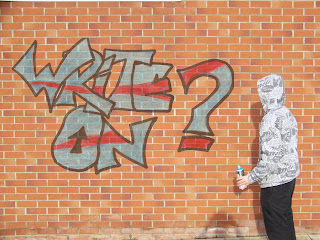Final production
Radio trailer
Print advert


Planning
When planning I watched multiple different videos once we had decided on the topic for our documentary in order to look at different ways of producing a documentary on graffiti.A digital camera was used throughout the prodcution of our programme for various different things. These included:
- Taking pictures of archive material
- Taking still images of graffiti
- Taking pictures of each other filming
The video camera was the most important piece of equipement used. It was used to film all of our interviews, establishing shots, shots of graffiti and chromakey background. We were as creative as possible when using the camera in order to make the programme interesting.
We used Adobe Premier Pro in the editing stages of our programme to delete anything we didn't need and to also make it look professional.
Adobe Audition was used for the creation of our radio trailer for our documentary.
Adobe Photoshop was used for the creation of our print advert which would appear in a newspaper to advertise our documentary.






The top screen grab is from my documentary and the bottom one is from the link below:
http://http//www.youtube.com/watch?v=5iHgbvmSeuI
The framing in both of these interviews have been filmed in medium close up and are both aligned to one side of the shot with a looking space for the interviewee. In both shots the eye line of the interviewee is roughly one third of the way down, following convention.
Graphics:


The screen grab from the left is from my documentary and the one from the right is form the link below:
http://http//www.youtube.com/watch?v=_I9-XxBAEsQ
Both of these onscreen graphics follow documentary conventions as they are on the opposite side to the interviewee and they also give the person's name and anchor their relation to the subject. There is also a use of simple, white typography and the top line font is bigger than the bottom.






The most difficult part of the editing process was perfecting the chromakey. Choosing the shots and cutting out the questions and choosing cutaways was easy but when applying the shots the background it became complicated. This was because the clips had to be perfectly inline with the end of the question. We managed to get everything in line after a few attempts.
After we had completed the five minutes and set up the timeline we added in the graphicd for our interviews. In order to follow convention we used a white font and the name was bigger than the person's relation to the subject.
One of the final things we did was edit our opening titles because we couldn't decide properly as a group. We sped up parts of it in order to fit the sound track and scanned in an image of our title in graffiti which we edited in photoshop as slightly dissolved in order to see the brick work through.

The final thing we did in the editing process was add the music tracks to our five minutes. Jon brought the tracks in recorded from home and we chose the final tracks we would use. Adding them was fairly simple and getting the sound levels right was quite easy. We used the keyframes tool on 'Premiere' to fade the song down at points, when we added in our voiceover and also at the end of shots.
We recorded the voice over in the radio studio and then had to increase the audio gain to make it sound better, overall it was an easy process and quickly done.
The editing process went well overall and was enjoyable, any problems we came accross were fixed.